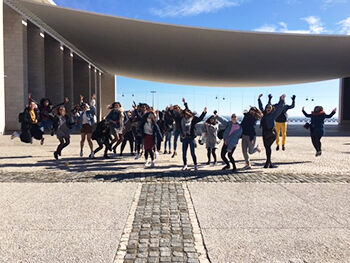University News Last updated 18 April 2018

Students across all years of BA (Hons) Interior Architecture and Design recently had the opportunity to spend a week in Portugal to get a wider understanding of architecture in a European context.
In conjunction with a second year module, the trip was designed to give students a first-hand experience of interiors across Porto and Lisbon, including a visit to the world famous contemporary architect Alvaro Siza and his practice.
The week’s itinerary started with a visit to the Porto School of Architecture. The School has been independent for over 20 years, and helped give rise to the modernist movement known as the School of Porto, which achieved national and worldwide prominence. Two of the School’s alumni have been distinguished with the Pritzker Architecture Prize.
Visits on the second day included a trip to the Boa Nova Tea House, with includes amazing views of the horizon through floor to ceiling windows. The busy day also included exploring the Leça Swimming Pools, a swimming area on the beach of Leça de Palmeria, along the cost of Porto, designed by Alvaro Siza.
The highlight of the week came on Wednesday, when students had the amazing opportunity to meet Alvaro Siza himself at his architectural practice. Mr Siza has been recognised in a host of awards across the world, including the Alvar Aelto Medal and the Urbanism Special Grand Prize of France in 2005. Students had the chance to explore the practice, speak to Mr Siza and gain a wider understanding of his approach, his views and experiences. It was a once in a lifetime opportunity for students and something they won’t forget.

At this point, the group moved from Porto to Lisbon to explore the Gare do Oriente, one of the main Portuguese transport hubs. Opened in 1994, the ambitious modernist station includes a Lisbon Metro station, a high-speed commuter and regional train hub, a local, national and international bus station, a shopping centre and a police station.
One of the most important aspects of the station for the students was the link to the urban environment in which it was constructed. The station, covered in a lattice structure of glass and metal is constructed of reinforced concrete.
Study trips like these are vital for students as it helps give first-hand experience of art, architecture and design in an international perspective.